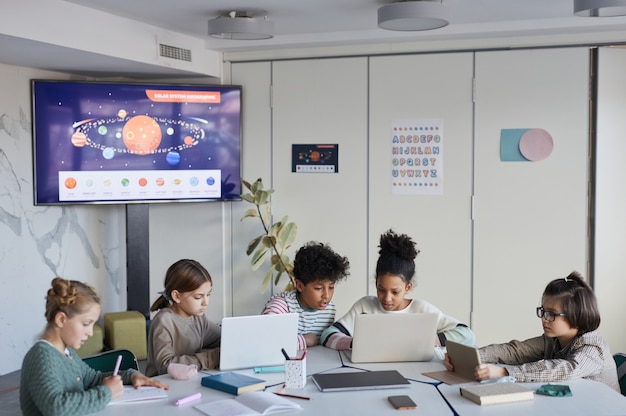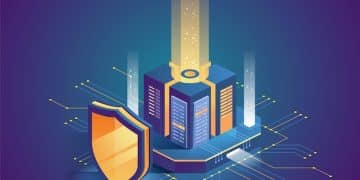The Future of Education: AI Transforming US Classrooms in 2025

The Future of Education: How AI is Transforming US Classrooms in 2025 involves personalized learning, automated administrative tasks, intelligent tutoring systems, and enhanced accessibility, although challenges like data privacy, equity, and the need for teacher training must be addressed.
The landscape of education is rapidly evolving, and at the forefront of this transformation is artificial intelligence. The future of education, specifically The Future of Education: How AI is Transforming US Classrooms in 2025, promises to be radically different from what we know today. Are we ready for this change?
The Rise of AI in Education: An Overview
Artificial intelligence is no longer a futuristic concept; it’s a present-day reality making significant inroads into various sectors, including education. In US classrooms, AI is poised to revolutionize teaching and learning processes, offering personalized experiences and unprecedented levels of efficiency.
AI in education refers to the application of machine learning and other computational techniques to enhance teaching methods, personalize learning experiences, and automate administrative tasks. This encompasses a wide range of tools and applications, all designed to improve educational outcomes.

Personalized Learning Experiences
One of the most promising applications of AI in education is personalized learning. AI algorithms can analyze student data to identify individual learning styles, strengths, and weaknesses. This allows educators to tailor instruction to meet the specific needs of each student, creating a more engaging and effective learning environment.
- Adaptive Learning Platforms: These platforms adjust the difficulty level of exercises based on student performance, ensuring that learners are always challenged but not overwhelmed.
- Customized Content Delivery: AI can curate educational content that aligns with individual student interests and learning preferences, making learning more relevant and enjoyable.
- Real-Time Feedback: AI-powered tools provide instant feedback on student work, allowing learners to identify and correct mistakes in real time.
Personalized learning is not merely about adapting content; it’s about creating a dynamic and responsive educational experience that caters to the unique needs of each learner, fostering a deeper understanding and greater engagement.
AI-Powered Tutoring Systems
Beyond personalized learning, AI is also enabling the development of intelligent tutoring systems that can provide students with individualized support and guidance. These systems can supplement traditional classroom instruction, offering students additional practice and assistance when needed.
AI-powered tutoring systems are designed to mimic the interactions of a human tutor, providing students with personalized feedback, hints, and explanations. These systems can be particularly beneficial for students who struggle with certain subjects or who need extra support outside of the classroom.
- 24/7 Availability: AI tutors are available around the clock, providing students with access to learning support whenever they need it.
- Personalized Feedback: These systems provide tailored feedback based on student performance, helping learners identify areas for improvement.
- Adaptive Instruction: AI tutors adjust their teaching approach based on student progress, ensuring that learners are always challenged appropriately.
AI tutors don’t replace teachers but act as valuable supplements, offering customized support that would be difficult for a single teacher to provide to every student individually.
Automating Administrative Tasks
AI isn’t just changing how students learn; it’s also transforming the administrative side of education. By automating routine tasks, AI can free up teachers and administrators to focus on more important responsibilities, such as student engagement and curriculum development.
Many administrative tasks, such as grading, attendance tracking, and scheduling, can be automated using AI-powered tools. This not only saves time but also reduces the risk of human error, ensuring greater accuracy and efficiency.

Examples of Automation in Education
- Automated Grading: AI-powered systems can automatically grade multiple-choice tests, essays, and other assignments, providing teachers with instant feedback on student performance.
- Attendance Tracking: AI can track student attendance using facial recognition technology or other biometric methods, eliminating the need for manual attendance taking.
- Personalized Communication: AI-driven chatbots can answer common student and parent questions, freeing up staff to handle more complex inquiries.
By automating these tasks, educators can reclaim valuable time, enabling them to devote more attention to instructional planning, student mentoring, and other activities that directly impact student success.
Enhancing Accessibility and Inclusivity
AI has the potential to make education more accessible and inclusive, particularly for students with disabilities or those who face other barriers to learning. AI-powered tools can provide personalized support and accommodations, ensuring that all students have the opportunity to succeed.
AI can facilitate the creation of accessible learning materials, such as transcriptions of lectures, translations of text, and audio descriptions of visual content. This makes it easier for students with disabilities to access and engage with educational materials.
Examples of Accessibility Enhancements
- Real-Time Translation: AI can translate spoken or written language in real time, allowing students who speak different languages to participate fully in classroom discussions.
- Text-to-Speech and Speech-to-Text: These technologies can convert text into speech and vice versa, making it easier for students with visual impairments or learning disabilities to access and create written content.
- Adaptive Assessments: AI can create assessments that are tailored to the individual needs of students with disabilities, ensuring that they are evaluated fairly and accurately.
AI enhances inclusivity by providing customized tools and support that enable all students, regardless of their challenges, to participate and succeed in education.
Addressing Ethical Considerations and Challenges
While AI offers tremendous potential for transforming education, it’s essential to address the ethical considerations and challenges that come with its implementation. These include issues such as data privacy, algorithmic bias, and the potential for job displacement.
Data privacy is a major concern as AI systems collect and analyze vast amounts of student data. It’s crucial to ensure that this data is protected and used responsibly, in accordance with privacy laws and ethical guidelines.
Key Challenges and Considerations
- Data Privacy: Implementing robust data security measures and obtaining informed consent from students and parents are essential to protect student privacy.
- Algorithmic Bias: AI algorithms can perpetuate existing biases if they are trained on biased data. It’s crucial to ensure that AI systems are fair and equitable, providing all students with equal access to opportunities.
- Teacher Training: Educators need training to effectively use AI-powered tools and to adapt their teaching methods to leverage the benefits of AI.
Carefully considering and addressing these challenges will ensure that AI in education enhances human educators, fostering a more equitable and ethically grounded learning experience.
The Role of Teachers in an AI-Driven Classroom
Some might fear AI will replace educators, but the reality is AI will augment and transform the role of teachers. In an AI-driven classroom, teachers will act as facilitators, mentors, and guides, providing students with personalized support and fostering critical thinking skills.
Teachers oversee AI-driven learning, giving specific help to struggling children, supporting social interaction, and encouraging critical thinking. They serve as essential role models in navigating the complexity of 21st-century education.
Evolving Teacher Roles
The shift towards AI-enhanced classrooms empowers teachers to focus on:
- Personalized Support: Giving one-on-one assistance based on AI-driven insights on student performance.
- Social-Emotional Development: Encouraging and supporting constructive relationships and personal growth.
- Critical Thinking: Cultivating complex problem-solving and creative skills for a transforming world.
The shift in education will redefine the roles of educators. Teaching will still be present with the help of AI to help make learning and education have more impact.
| Key Point | Brief Description |
|---|---|
| 💡 Personalized Learning | AI adapts teaching to individual student needs. |
| 🤖 AI Tutors | 24/7 support with personalized feedback. |
| ⏱️ Automation | AI automates grading for teachers. |
| 🌍 Accessibility | Tools translate in real time, helping the ones in need. |
Frequently Asked Questions
AI in education involves using machine learning to improve teaching, personalize learning, and automate tasks, creating better educational outcomes for students.
AI analyzes student data to tailor content, adjust difficulty, and provide real-time feedback, catering to unique learning styles and improving comprehension.
No, AI enhances teaching by automating tasks and providing personalized support, allowing teachers to focus on mentoring and critical guidance for students.
Concerns include maintaining data privacy, addressing algorithmic bias, and ensuring equitable access, requiring careful management and ethical guidelines.
AI provides real-time translation and text-to-speech tools, making educational materials accessible for students with disabilities or those who speak different languages.
Conclusion
As we look towards 2025, the integration of AI into US classrooms promises a transformative shift in education – The Future of Education: How AI is Transforming US Classrooms in 2025. By embracing these advancements thoughtfully, and addressing its challenges proactively, educators can make a future that helps students more.





